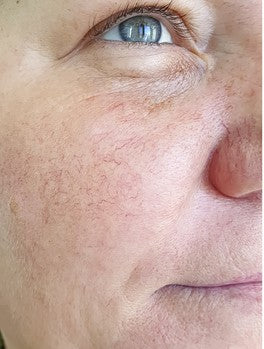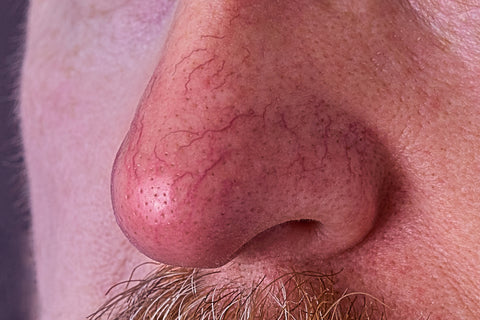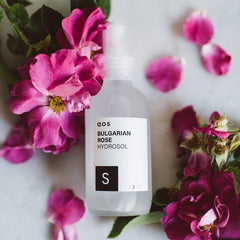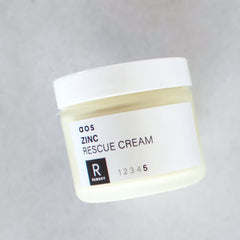Over the last few decades, I've had the pleasure of meeting and consulting with thousands of customers, hundreds of estheticians and dozens of doctors and dermatologists and the one thing we all agree on is that rosacea is a confusing and frustrating condition. No one wants to see redness in their skin, especially on their face and rosacea is especially difficult because not only is it not well understood, the triggers and successful treatments vary with every person.
But, there is hope! We've seen many customers get their rosacea under control and even into "remission" (no visible symptoms) with some thoughtful care. It takes a little focus and dedication, but sensitive, problematic skin is where we really shine when we're formulating. Both Elisa and I have very sensitive skin prone to redness, so we really understand. Let's dive in and learn how to get your skin calm and happy!
What is Rosacea?
Rosacea is an inflammatory skin condition characterized by redness and/or flushing, generally on the cheeks and nose. You may see broken capillaries (tiny blood vessles), spider veins showing through the skin. There are two types:

1. Erythematotelangiectatic rosacea: A pink to red rash

2. Papulopustular rosacea: a red rash combined with small, pus-filled bumps resembling acne.

Untreated rosacea may eventually lead to thick, rough skin, especially on the nose and it may have an enlarged, bulbous appearance.
Less commonly, rosacea sufferers may experience eye irritation with red, itchy, gritty, or watery eyes and sore, swollen lids. In rare cases, rosacea may extend to the ears, neck, scalp and chest.
Symptoms may be continuous or may come and go, flaring up for sometimes weeks or months, then subsiding. Rosacea is still not well understood. It can be difficult to diagnose and has been mistaken for other skin problems like acne and dermatitis.
Causes
There is not an agreed-upon cause of rosacea, but some people think that genetics may be a contributor. It's most common in fair-skinned people, middle-aged and older and more women than men, but men are worse. Systemic, inflammatory disease.
What Makes it Worse
While everyone is different, here are some things that commonly cause rosacea symptoms to flare up:
Spicy food
Hot or cold water or air
Sun / UV exposure
Overheating during exercise
Stress
Drinking hot beverages
Alcohol (wine, beer, spirits)
Foods: Dairy, citrus, tomatoes, chocolate, aged cheese and processed meats, refined sugar.
Some medications may cause a flare up or worsen symptoms.
Skin care products that have harsh cleansing agents, synthetic fragrances
Rosacea Seems to Follow a 4 Stage Progression
1 Pre-Rosacea: temporary flushing
2 Mild Rosacea: longer lasting flushing
3 Moderate Rosacea: rash, visible blood vessels and broken capillaries
4 Severe Rosacea: skin thickens and enlarges, firm, red bumps
Treatments For Rosacea
There is no known cure, but people have been able to control it and even keep symptoms in remission. *Not all rosacea sufferers are sensitive to the same triggers. Be a scientist. Pay attention and keep a journal to identify your triggers.
Things to Try:
Avoid: very hot drinks and food and spicy foods, overheating during exercise, drinking alcohol and too much sun exposure.
Use a gentle sulfate and fragrance-free cleanser every day.
Wear sunscreen.
Products containing sulfer may help.
Azelaic acid at prescription strength (anti-inflammatory, gentle exfoliant)
Gently clean eyelids if they are affected. Avoid rubbing them.
Eat cooling and anti-inflammatory foods.
Manage stress.
Find a Skincare Routine and Stick to It
STEP 1 Cleanse - Very gentle daily cleansing can remove dead skin buildup. Use your fingertips, rather than a scrubby cloth. Avoid cleansers with harsh ingredients like drying sulfates or synthetic fragrances. I recommend a soap free cleanser like our Apple Chamomile Cleansing Gel. The gentle apple amino acids cleanse and exfoliate without irritating while oats calm the skin. Always rinse with tepid water (avoid hot or cold water).
STEP 2 Exfoliate weekly and GENTLY. Use a scrub with round beads like our Cucumber Face Polish that rolls away dead skin without tearing or damaging the skin. Be sure to go gently- don't rub too hard.
STEP 3 Tone Avoid alcohol based toners. Alcohol is drying and damaging to skin cells. Opt for something gentle and calming like the Bulgarian Rose Hydrosol. This one-ingredient product is cooling and calming while it restores the skin's pH after cleansing.
STEP 4 Treat your skin with a calming serum or specialty cream. Capillary - strengthening horse chestnut extract helps prevent broken blood vessels. Stem cells help rebuild the delicate, damaged skin. Try our Apple Stem Cell Radiance Serum that relies on both of these. I've seen many people find relief with our Zinc Rescue Cream as well.
STEP 5 Moisturize and Protect your skin with natural, gentle, calming ingredients like chamomile, plantain, marshmallow and calendula. Use products with ingredients that strengthen capillaries and maintain a healthy moisture barrier. (reference blog). If it stings, discontinue use. Many of our customers have enjoyed the Apple Stem Cell Daily Radiance Cream, as it contains zero essential oils, calming herbs, and apple stem cells and horse chestnut extract to rebuild the skin.
** Always wear a mineral sunscreen. Zinc oxide is very soothing. Chemical sunscreen ingredients can cause irritation and stinging. Try our Broad Spectrum Mineral Sunshade Lotion (spf 30+) that's packed full of soothing herbs like jasmine flowers and shea butter.
Get Professional Help: Talk to your dermatologist. Laser treatments are available for redness, broken capillaries and pustules. Prescription medications include metronidazole, ivermectin and oral antibiotics (short course).
Read our article on how to rebuild your moisture barrier.
SHOP THIS ARTICLE:
APPLE CHAMOMILE CLEANSING GEL
CUCUMBER FACE POLISH
BULGARIAN ROSE HYDROSOL
APPLE STEM CELL RADIANCE SERUM
APPLE STEM CELL DAILY RADIANCE CREAM
BROAD SPECTRUM MINERAL SUNSHADE LOTION
ZINC RESCUE CREAM










